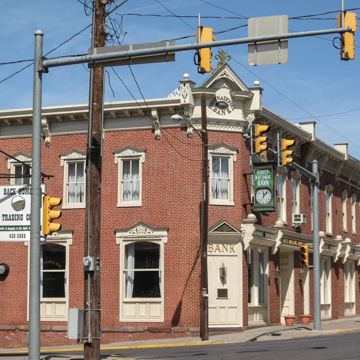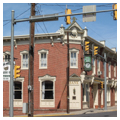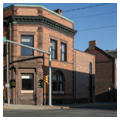A group of banks stands at this intersection and their designs are evidence of Mifflintown's connections to national trends. The Italianate two-story brick and wood-trimmed First National Bank, established in 1864 by Doty, Parker and Company, was constructed shortly after the fire of 1873. It has a chamfered corner entrance with crested aedicule, segmental-arched windows, and a bracketed cornice. The Juniata Valley Bank opened in John Patterson's Italianate house (now Union Mason Lodge No. 324) at 9 S. Main Street in 1867. Since 1981, its administrative offices have occupied a c. 1833 five-bay Federal brick building, and its main office (Bridge and S. Main streets) is a parapeted orange brick structure with a chamfered corner. The importance of banking in the development of the region is evident in the county's various branch banks. In Richfield is a small stone Greek Revival bank (571 Main Street) and at Port Royal, the Classical Revival bank (1926) was designed by Morgan, French and Company of New York City.
You are here
Bank Buildings
If SAH Archipedia has been useful to you, please consider supporting it.
SAH Archipedia tells the story of the United States through its buildings, landscapes, and cities. This freely available resource empowers the public with authoritative knowledge that deepens their understanding and appreciation of the built environment. But the Society of Architectural Historians, which created SAH Archipedia with University of Virginia Press, needs your support to maintain the high-caliber research, writing, photography, cartography, editing, design, and programming that make SAH Archipedia a trusted online resource available to all who value the history of place, heritage tourism, and learning.





